 Ireland is an island, and as such it has always had a close relationship with the sea. Coastal communities and fishing towns were once urban centres, shipbuilding was one of the main industries in the industrial north at one point boasting the biggest shipyard in the world. Even the RMS Titanic arguably the most famous ship in the world was built on the island. (and was it was Okay when it left us!) Many people over the years have left the island by sea, So the flags used at sea deserves a post to itself.
Ireland is an island, and as such it has always had a close relationship with the sea. Coastal communities and fishing towns were once urban centres, shipbuilding was one of the main industries in the industrial north at one point boasting the biggest shipyard in the world. Even the RMS Titanic arguably the most famous ship in the world was built on the island. (and was it was Okay when it left us!) Many people over the years have left the island by sea, So the flags used at sea deserves a post to itself.St George's Cross
 The earliest known use of flags in Irish Waters is the cross of St George, patron saint of England. The use of flags at sea to distinguish a vessel's nationality roughly dates from the middle ages, a time when Ireland was a Lordship of England. You might remember the incident in 1537 from Part 4, when a Portuguese ship was captured by a local chieftain, and the government's response of attacking the village and castle, on which "St George's Standard" was put up. There can be little doubt what flag those government vessels flew. St George's Cross appeared on many other nautical flags, such as ensigns and jacks, including the former flag of the Commissioners of Irish Lights used until 1970 (right) and is still used on the House Flag of the Royal National Lifeboat Institution (RNLI), who operate all over the British Isles.The House Flag flown from Lifeboat Stations in the Republic of Ireland. is the same as that in the UK.
The earliest known use of flags in Irish Waters is the cross of St George, patron saint of England. The use of flags at sea to distinguish a vessel's nationality roughly dates from the middle ages, a time when Ireland was a Lordship of England. You might remember the incident in 1537 from Part 4, when a Portuguese ship was captured by a local chieftain, and the government's response of attacking the village and castle, on which "St George's Standard" was put up. There can be little doubt what flag those government vessels flew. St George's Cross appeared on many other nautical flags, such as ensigns and jacks, including the former flag of the Commissioners of Irish Lights used until 1970 (right) and is still used on the House Flag of the Royal National Lifeboat Institution (RNLI), who operate all over the British Isles.The House Flag flown from Lifeboat Stations in the Republic of Ireland. is the same as that in the UK. St Patrick's Saltire
The first flag of Ireland, the saltire known as St Patrick's Cross. One of the earliest references to the flag is a picture of of flying from a ship.(Hibernia 1576, John Goghe). The flag also appears on many flag charts, most of them naval, which suggest that this flag must have been used by Irish ships. One such book is Neptune Francois published in Amsterdam as early as 1693. This depicts a saltire on a white field, which in some hand coloured copies is red. Above and below are the French and Dutch words for Irish: Ieres and Irlandois.
Further evidence to this flag being used by the Irish at sea comes from a 1785 newspaper report from Waterford states about ships leaving for the colonies that:"Upwards of forty vessels are now in our harbour, victualling for Newfoundland, of which number thirteen are of our own nation, who wear the St Patrick's flag (the field of which is white, with a St Patrick's cross, and an harp in one quarter.)"
It was even adopted for the House Flag and jack of the Republic of Ireland's state shipping company, Irish Shipping until it was liquidated in 1984, it is still included in the house flag of the Commissioner of Irish Lights. For more on St Patrick's Saltire see Part 7.
 |
| Irish ensign according to 1785 newspaper |
It was even adopted for the House Flag and jack of the Republic of Ireland's state shipping company, Irish Shipping until it was liquidated in 1984, it is still included in the house flag of the Commissioner of Irish Lights. For more on St Patrick's Saltire see Part 7.
Red Ensign
 |
| extract of Dutch painting depicting the burning of the English Fleet |
The British ensign system consisted of red, white and blue flags with the national flag in the canton (St George's/St Andrews Cross before 1707 and Union Flag post 1707). There is references to red and blue ensigns featuring harps being used by the various naval ships often with Irish connections. A Dutch Painting depicting the burning of the English fleet during their raid on the Medway in 1667, the worst defeat of the Royal Navy (something of which thankfully didn't happen often). In this painting the English ships are flying a red ensign depicting a harp.
 |
| Irish Customs ensign 1768 |
With the establishment of modern customs, these vessels had to be distinguished from other ships. Ireland had its own Customs and as such Irish customs vessels fly a distinct ensign, which had a harp ensigned with a crown. There is evidence of this flag being used in 1768.
When Ireland became integrated into the United Kingdom the red ensign without any insignia became the normal national flag at sea. This became official in the Merchant Shipping Act of 1854, which stated the red ensign should be the national colours of all British Civil ships.
| Irish Merchant ensign 1841-1939, Still used by NI and other British registered vessels |
Coincidentally after the Irish Free State was formed the red ensign remained the official civil ensign of the new state, as the Tricolour was reserved for naval and other state vessels. There are stories of dissatisfied skippers hauling down the red duster (which is what it is commonly called) as soon as they entered international waters, and flying the tricolour unofficially. It was not until the outbreak of World War two, during which the Irish Republic was neutral, that the tricolour was extended to all ships, to avoid them being mistakenly attacked by Axis navies. The red ensign is still used by vessels registered in Northern Ireland as its the UK's civil ensign.
Green Ensign
The Green Ensign is an interesting flag surrounded by myth and debate. Some speculate it might have had official status at some point, but others go as far to say it never existed at all despite it appearing in several historical references. It certainly had no official status after the Irish Act of Union, however there is evidence that it was still used regardless. One theory is that at some point naval ensigns like the ones mentioned above were adopted by civil ships who changed the colour to green.
There are various reports of "green ensigns" being used as the national colours of Irish vessels. The Royal United Service Institute produced a pamphlet on flags in 1895, written by a Rear Admiral Bloomfield. It depicts a green flag bearing a harp, with a St Patrick's Cross in the canton and states it was used in Irish waters between 1688 and 1694. However no source is given with it, so where the Admiral got his information from might be suspect. A better source depicting a green ensign from about the same time is the National Geographic Flag Book (1917), which depicts a green ensign with a harp, and St George's Cross in the canton. It states that this flag was the Irish ensign used at the beginning of the 18th Century. It also states that the author got their information from a book by John Beaumont published in 1701.
The fact that the book states it was used at the beginning of the 18th Century suggests it might have been used in the late 17th Century and it is possibly this flag with the St George Cross that Admiral Brook intended rather than St Patrick's Cross. Also the fact that its mentioned at the beginning of the century suggests that the St George Cross was replaced with the Union Jack (1606) in following the Act of Union between England and Scotland in 1707. Despite the Act of Union (1707) St Georges Cross variant of the flag continues to appear in many flag charts, although some were quoting historical examples or using out of date sources. Of course another explanation could be that there was no official national merchant ensign (the first Merchant Shipping Act was not until 1786) so it could be possible that the St George's variant could have stayed in use. It could also be the case that it was used in conjunction with the British red ensign.
The St George Cross was all but phased out by 1800, being replaced by a Union Flag. There are records of ships flying variants of this flag throughout the 19th Century, One such example happened in Spain. in 1846 the Governor of Gibraltar forwarded a report from the Admiralty Agent of the British Steam Packet 'Royal Tar' to William Gladstone, Colonial Secretary. The Agent had reported that while at anchor at Cadiz, a small trading brig belonging to Harding & Co. of Dublin had hoisted a green Ensign with a Harp and Crown in the fly and a Union Jack in the corner of it. He added that as there was no recognised flag of that colour and pattern belonging to the United Kingdom, he had expressed his intention of hauling it down as had been done on two other occasions in Ireland on board of the same vessel. The captain of the brig was reported to have said that he hoisted the flag in compliment to H.M. Pendant.
In the covering letter the Governor wrote that in his opinion such a Flag ought not to be allowed to fly in any port where there was a British Consul and that if met with on the High Seas might be dealt with as the emblems of a piratical vessel. The British Consul at Cadiz certainly would be authorised to hold from it, all Consular aid and make a protest to the Spanish Authorities in the name of the Queen's Government against its display.
The report was passed on to the Admiralty via the Home Office. The Admiralty Secretary replied that, "My Lords have no observation to make on the subject."
 |
| extract of Boal's Universal Display of the Naval flags of all the Nations in the World (1783) |
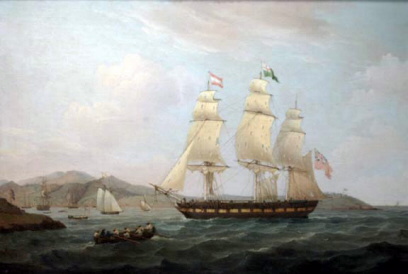 |
| Ship flying the UK red ensign and what appears to be an Irish green ensign from her mainmast |
 |
| extract of National & Commercial Flags of All Nations Published G.W. & C.B. Colton & Co. in 1874 |
In the covering letter the Governor wrote that in his opinion such a Flag ought not to be allowed to fly in any port where there was a British Consul and that if met with on the High Seas might be dealt with as the emblems of a piratical vessel. The British Consul at Cadiz certainly would be authorised to hold from it, all Consular aid and make a protest to the Spanish Authorities in the name of the Queen's Government against its display.
The report was passed on to the Admiralty via the Home Office. The Admiralty Secretary replied that, "My Lords have no observation to make on the subject."
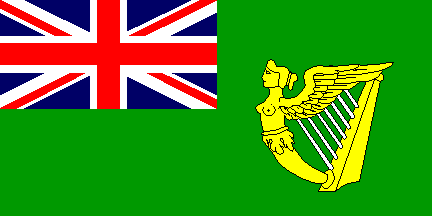 The suggestion of withholding consular assistance is most interesting as one of the possible reasons why the green ensign was used instead of a red ensign or indeed a nationalist flag, was to express an Irish identity, but keep the protection and influence of Britain, who had the biggest navy in the world. It continues to appear in flag charts throughout the Victorian period, it also appears in encyclopedias and atlases, possibly to fulfill the vexillologists need for a flag, and the green ensign being similar to other British colonial flags, (although Ireland was strictly speaking an integral part of the United Kingdom rather than a colony or dominion).
The suggestion of withholding consular assistance is most interesting as one of the possible reasons why the green ensign was used instead of a red ensign or indeed a nationalist flag, was to express an Irish identity, but keep the protection and influence of Britain, who had the biggest navy in the world. It continues to appear in flag charts throughout the Victorian period, it also appears in encyclopedias and atlases, possibly to fulfill the vexillologists need for a flag, and the green ensign being similar to other British colonial flags, (although Ireland was strictly speaking an integral part of the United Kingdom rather than a colony or dominion).
It may have continued to be used as an alternative to the red ensign right up until 1939.
The White Ensign
The White ensign is used by UK warships, however it is also flown by the Royal Yacht Squadron, the Irish version, the Royal Irish Yacht Club also flew a white ensign, however the third quarter of the flag depicted a harp on blue field:
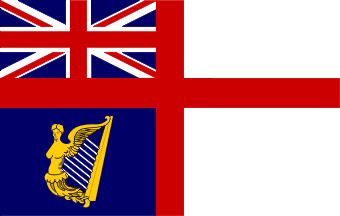 |
| Historical RIYC ensign |
The white ensign is still traditionally used by the RIYC, however it is not defaced with a red cross, displays a crowned harp in the fly and has an Irish tricolour in the canton. Interestingly the crown is the Tudor crown which is not currently used in Commonwealth heraldry, suggesting a historical use of the title "royal" rather than a connection to the UK or Royal Family.
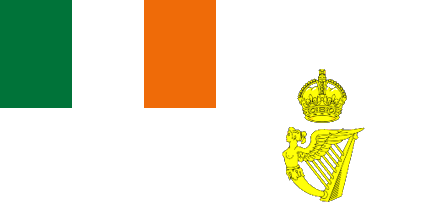 |
| Current RIYC ensign |
Blue Ensign
There are very few references to Irish blue ensigns, those were ensigns used by the government but there are some notable examples, such as the Congested Districts Board ensign, which featured a crowned harp and the letters "CDB"
The ensign of the Department of Agriculture, Dublin also flew a blue ensign, this had a white disk with a wreath of shamrock, inside was a blue disk with a gold Irish harp. Vessels of the Northern Ireland Government flew a blue ensign, with a white disk featuring the letters "GNI" between 1929 and 73.
The Commissioners of Irish Lights flew a blue ensign defaced with its badge featuring a light house, this is still used by CIL vessels registered in the United Kingdom, although the modern use of helicopters has seen the use and number of CIL vessels and ensigns as a result decrease.
In the waters around modern Ireland however blue ensigns are mostly associated with yacht clubs. In Northern Ireland both the Royal Ulster Yacht Club and Royal North of Ireland Yacht Club fly UK blue ensigns featuring their club badge:
Yacht Clubs in the Republic of Ireland also use Blue ensigns with a club badge in the fly, but tricolour in the hoist, like the national yacht club ensign:
The Green Flag
Never used officially but there are various examples of green harp flags being flown by vessels often in protest, often a warship was despatched to request the vessel to fly the correct colours. The most notable example of a green harp flag being flown at sea, is the first recorded use of the flag. From the mast of the Frigate St Francis which was a ship of the Confederation of Kilkenny in 1642 mentioned in part 10. To this flag is appropriately the Irish Naval Jack.
 |
| Irish Defence Forces, Naval Jack |
The Tricolour
The Irish tricolour was the state ensign from the country's inception, it was not officially used by merchant and civil shipping to begin with though, as already stated the British red ensign was used. The only reason it was extended to all ships registered in the Republic of Ireland was when war broke out in Europe in 1939. Eire was officially neutral throughout the entire conflict (although many Irishmen left to serve in the Allied forces) where as the United Kingdom was not. Therefore Irish ships needed to distinguish themselves as neutral, therefore the use of tricolour was extended to all ships, and remains the case today (with the exception of certain yacht clubs who use their own special ensigns, with a tricolour in the canton). In fact many ships painted large tricolours to their hulls with the word "Eire" (Ireland) in large white colours, so as not to be mistaken. This did not however help the SS Irish Oak when she was torpedoed and sank by German submarine U-607 in 1943.
House flags were and are common with most ship companies, and come in all shapes and sizes. The flag of the White star line was a red swallow tailed flag bearing a white five pointed star.
 |
| SS Irish Oak listing to port after being torpedoed by a German Submarine in 1943 |
RMS Titanic
I suppose this post wouldn't be complete without mentioning the flags flown from the most famous vessel in the world (even if it is famous for all the wrong reasons), built in Belfast. This is based on photographs I have seen. Here are the flags from bow to stern:
Jack Staff - British Civil Jack
The use of the Union Jack at sea has been restricted to warships since the 1600s, therefore civilian vessels used a version with a white boarder to distinguish it from the Naval Jack.This flag probably wouldn't have been used at sea.
Foremast - USA flag
Although built and registered in the United Kingdom, the company that owned Titanic, the White Star Line was American. It therefore flew the flag of the United States from the foremast as this was the nationality of the company if not the ship, this was a common practice of the time. The flag Titanic flew had 46 stars, and was only used for four years before two other stars were added in July 1912.
Aftmast- House flag
Ensign- British Blue Ensign
This flag flown from the stern represented the ship's nationality. The red ensign is used by civil ships and the blue by government vessels. As Titanic was registered as a "Royal Mail Steamer (RMS)" and carried "His Majesty's Mail" she had a warrant to use the blue ensign.
Mail Pennants
I havn't seen this flag in any photographs but as Titanic was an RMS it is likely that she flew the Royal Mail pennant.
Here is a great wee guide to flags used by White Star Line.
Here is a great wee guide to flags used by White Star Line.
For more in this series see the links below or click the label History of Irish flags:
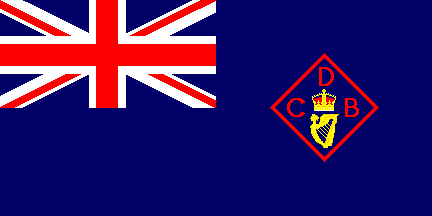
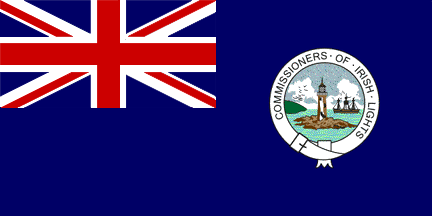
_ensign_(alternate).svg/500px-National_Yacht_Club_(Ireland)_ensign_(alternate).svg.png)



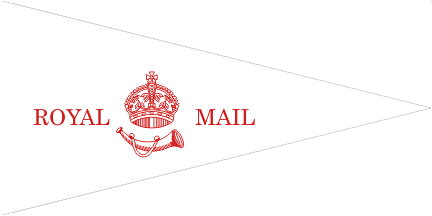

No comments:
Post a Comment